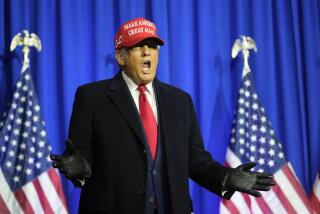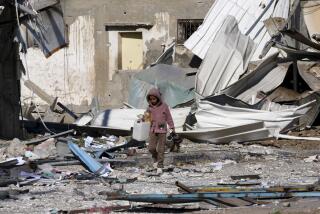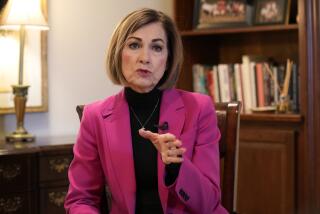Q&A: What will U.S. foreign aid look like in the age of Trump?
As the Trump administration slashes the State Department’s payroll and turns U.S. foreign policy inward, worries have spread through the U.S. Agency for International Development, which directs most of the government’s development assistance worldwide.
Foreign aid accounts for about 1% of the federal budget, which President Trump regards as too much. He has proposed cutting USAID funding by more than one-third. While congressional budget negotiators have pledged to restore some of the funding, it has reignited a debate over whether foreign assistance advances U.S. interests in developing nations or promotes dependency and waste.
USAID Administrator Mark Green acknowledges that in the current political climate the agency must be “as effective and efficient as we possibly can.”
Green, a Republican former congressman from Wisconsin who has also served as U.S. ambassador to Tanzania, spoke to The Times following the recent Global Entrepreneurship Summit in Hyderabad, India, where he was part of the U.S. government delegation led by Trump’s daughter Ivanka. Following are excerpts of the conversation:
At the summit, USAID announced a bond in which private companies will invest in health facilities in the Indian state of Rajasthan, and the agency will pay back the investment based on results. Why is this important?
It’s basically pay-for-performance. This is the first U.S. government health development impact bond. We’re starting to use these concepts more. It causes the private sector to compete, and it’s also great because it incentivizes performance. From our perspective, it’s golden. It ensures outcomes.
Given the increasing skepticism in the U.S. about foreign aid, is this kind of foreign aid model more sellable back home?
It’s a way of showing people that the development sector wants to push itself to try new things. When I came to this post, I made it very clear that business as usual wasn’t going to get the outcomes we wanted. I’m from the Midwest, I’m from the heartland, and I think the skepticism that Americans sometimes have is they believe that commitments are open-ended.
With the development impact bond and some of the challenges to the private sector, we’re showing that we’re changing some of the ways we’re doing business and we’re demanding results. India is such a good example because it wasn’t so long ago that India was a food aid recipient. And here it is an equal partner with the U.S.
As a candidate, Donald Trump suggested that foreign aid was a waste of tax dollars. Have you had to persuade him of USAID’s mission?
I would draw your attention to his speech at the U.N. General Assembly, which referenced PEPFAR [the presidential global anti-AIDS initiative], malaria and the new Women’s Entrepreneurship Finance Initiative [launched by Ivanka Trump]. I thought that was a very good sign.
I met President-elect Trump in January, and my pitch to him was very simple: I said, “Mr. President, I believe that what we do in development, if done right, can help you achieve just about every one of your strategic priorities.’” I have only chatted with him once briefly since then, in person, but we’ve had nothing but support.
How concerned are you about budget cuts?
I think the budget situation at the very least reminds us that we have to be as effective and efficient as we possibly can. My first trip was to the Horn of Africa, Ethiopia and Sudan, where I saw astounding needs. We came back and we talked about it very openly.
Does it put pressure? Of course it does. It forces us to scrub everything that we do, and we are. But my favorite moment from the trip was, we were walking through a food distribution site [in eastern Ethiopia] and there was a lady sitting down with her kids. She had just received her sack of grain. She asked me: “Can you help me with irrigation so I never have to do this again?” If we capture that desire, we can do anything.
Climate change is fueling many of the humanitarian crises USAID has to respond to. Yet you have colleagues in the Cabinet who are not as convinced of climate change as some would like.
I look at this through a development lens. Our obligation is to help people withstand future shocks. It’s a matter of record that Ethiopia has had three consecutive years of drought. We will certainly do what we can to help foster resilience. Where there are signs of changing climate, where the climactic conditions are having obvious fallout, if our partner is looking for us to work with them on that, we will.
But if a changing climate is making these disasters worse, how can you address them if not everyone in the government is on the same page?
Whenever the interagency administration gets together to formulate policy, I’m proud to say I’m often involved. When I am, we bring forward our point of view. I think it’s crucial that we’re able to point out: Look, Ethiopia has just gone through three consecutive years of drought. They are on the famine watch list for 2018. That’s a matter of record. We will try to help them plan.
You’re in the midst of a major reorganization at the State Department and USAID. Positions are going unfilled and there are reports of senior staff leaving. Are you satisfied with the level of staffing?
We haven’t had people leaving USAID. We are subject to a hiring freeze. What we’ve tried to do as long as we’re under the freeze is to manage our staffing needs the best way we can. We’ve received some waivers [to hire critical personnel] on a case-by-case basis. I need more people. And we’re working on it.
Follow @SBengali on Twitter for more news from South Asia
ALSO
U.S. foreign aid: A waste of money or a boost to world stability? Here are the facts
U.S. development aid — harmful handout or helpful hand up?
More to Read
Start your day right
Sign up for Essential California for news, features and recommendations from the L.A. Times and beyond in your inbox six days a week.
You may occasionally receive promotional content from the Los Angeles Times.







